Experimental Investigation of Fluid Flow through Zinc Open-Cell Foams Produced by the Excess Salt Replication Process and Suitable as a Catalyst in Wastewater Treatment
Abstract
1. Introduction
2. Materials and Methods
Flow Laws
- The flow is horizontal and uniform all along the main flow z-direction (Figure 2);
- Air is treated as a monophasic Newtonian fluid;
- The dense wall effect in our case is neglected because the tested foams are relatively dense [2];
- The static gas pressure was constant throughout the porous medium and was equal to the difference between the inlet and outlet pressures of the test section.
3. Experimental Process
4. Results and Discussion
4.1. Description of Air Flow through ESR Foams
4.2. Identification of Flow Regimes
4.3. Laws Governing Air Flow through ESR Foams
4.4. Residuals Analysis
4.5. Air Flow Properties of ESR Foams
4.6. Sample Length Effect on Airflow Regimes
4.7. Qualitative description of the ESR foams
5. Conclusions
Author Contributions
Funding
Data Availability Statement
Conflicts of Interest
References
- Harshit, K.; Gupta, P. Advanced Research Developments and Commercialization of Light Weight Metallic Foams. In Handbook of Nanomaterials and Nanocomposites for Energy and Environmental Applications; Springer: Berlin/Heidelberg, Germany, 2020; pp. 1–31. [Google Scholar]
- Goodall, R.; Mortensen, A. 24—Porous Metals A2—Laughlin, David E. In Physical Metallurgy, 5th ed.; Hono, K., Ed.; Elsevier: Oxford, UK, 2014; pp. 2399–2595. [Google Scholar]
- Durmus, F.Ç.; Maiorano, L.P.; Molina, J.M. Open-cell aluminum foams with bimodal pore size distributions for emerging thermal management applications. Int. J. Heat Mass Transf. 2022, 191, 122852. [Google Scholar] [CrossRef]
- Ashby, M.F.; Evans, T.; Fleck, N.; Hutchinson, J.W.; Wadley, H.N.G.; Gibson, L.J. Metal Foams: A Design Guide; Elsevier Science: Amsterdam, The Netherlands, 2000. [Google Scholar]
- Do, T.M.; Byun, J.Y.; Kim, S.H. An electro-Fenton system using magnetite coated metallic foams as cathode for dye degradation. Catal. Today 2017, 295, 48–55. [Google Scholar] [CrossRef]
- Klegova, A.; Pacultová, K.; Kiška, T.; Peikertová, P.; Rokicińska, A.; Kuśtrowski, P.; Obalová, L.J.M.C. Washcoated open-cell foam cobalt spinel catalysts for N2O decomposition. Mol. Catal. 2022, 533, 112754. [Google Scholar] [CrossRef]
- Choe, Y.J.; Kim, J.; Byun, J.Y.; Kim, S.H.J.C.T. An electro-Fenton system with magnetite coated stainless steel mesh as cathode. Catal. Today 2021, 359, 16–22. [Google Scholar] [CrossRef]
- Sahu, S.; Ansari, M.Z. A Study on Manufacturing Processes and Compressive Properties of Zinc-Aluminium Metal Foams. Am. J. Mater. Sci. 2015, 5, 38–42. [Google Scholar]
- Chethan, A.; García-Moreno, F.; Wanderka, N.; Murty, B.; Banhart, J. Influence of Oxides on the Stability of Zinc Foam; Springer: Berlin/Heidelberg, Germany, 2011; Volume 46, pp. 7806–7814. [Google Scholar]
- Yu, S.; Liu, J.; Wei, M.; Luo, Y.; Zhu, X.; Liu, Y. Compressive property and energy absorption characteristic of open-cell ZA22 foams. Mater. Des. 2009, 30, 87–90. [Google Scholar] [CrossRef]
- Hassein-Bey, A.H.; Belhadj, A.-E.; Gavrus, A.; Abudura, S. Elaboration and Mechanical-Electrochemical Characterisation of Open Cell Antimonial-lead Foams Made by the “Excess Salt Replication Method” for Eventual Applications in Lead-acid Batteries Manufacturing. Kem. Ind. Časopis Kemičara Kem. Inženjera Hrvat. 2020, 69, 387–398. [Google Scholar] [CrossRef]
- Dukhan, N. Metal Foams: Fundamentals and Applications; Destech Publications: St, Lancaster, PA, USA, 2013. [Google Scholar]
- Savaci, U.; Yilmaz, S.; Güden, M. Open cell lead foams: Processing, microstructure, and mechanical properties. J. Mater. Sci. 2012, 47, 5646–5654. [Google Scholar] [CrossRef]
- Banhart, J. Manufacture, characterisation and application of cellular metals and metal foams. Prog. Mater. Sci. 2001, 46, 559–632. [Google Scholar] [CrossRef]
- Lu, X. Fluid Flow and Heat Transfer in Porous Media Manufactured by a Space Holder Method; Springer Nature: Berlin/Heidelberg, Germany, 2020. [Google Scholar]
- Lage, J.; Antohe, B.; Nield, D. Two types of nonlinear pressure-drop versus flow-rate relation observed for saturated porous media. J. Fluids Eng. 1997, 119, 700–706. [Google Scholar] [CrossRef]
- Skjetne, E. High-Velocity Flow in Porous Media; Norwegian University of Science and Technology: Trondheim, Norway, 1995. [Google Scholar]
- Kececioglu, I.; Jiang, Y. Flow through porous media of packed spheres saturated with water. J. Fluids Eng. 1994, 116, 164–170. [Google Scholar] [CrossRef]
- Dukhan, N.; Bağcı, Ö.; Özdemir, M. Metal foam hydrodynamics: Flow regimes from pre-Darcy to turbulent. Int. J. Heat Mass Transf. 2014, 77, 114–123. [Google Scholar] [CrossRef]
- Dukhan, N.; Patel, K. Effect of sample’s length on flow properties of open-cell metal foam and pressure-drop correlations. J. Porous Mater. 2011, 18, 655–665. [Google Scholar] [CrossRef]
- Mauroy, B.; Filoche, M.; Andrade Jr, J.; Sapoval, B. Interplay between geometry and flow distribution in an airway tree. Phys. Rev. Lett. 2003, 90, 148101. [Google Scholar] [CrossRef]
- Firoozabadi, A.; Thomas, L.; Todd, B. High-Velocity Flow in Porous Media (includes associated papers 31033 and 31169). SPE Reserv. Eng. 1995, 10, 149–152. [Google Scholar] [CrossRef]
- Andrade, J., Jr.; Costa, U.; Almeida, M.; Makse, H.; Stanley, H. Inertial effects on fluid flow through disordered porous media. Phys. Rev. Lett. 1999, 82, 5249. [Google Scholar] [CrossRef]
- Coulaud, O.; Morel, P.; Caltagirone, J. Numerical modelling of nonlinear effects in laminar flow through a porous medium. J. Fluid Mech. 1988, 190, 393–407. [Google Scholar] [CrossRef]
- Takhanov, D. Forchheimer Model for Non-Darcy Flow in Porous Media and Fractures. Masters Thesis, Imperial College London, London, UK, 2011. [Google Scholar]
- Skjetne, E.; Auriault, J.-L. High-Velocity Laminar and Turbulent Flow in Porous Media. Transp. Porous Media 1999, 36, 131–147. [Google Scholar] [CrossRef]
- Sivanesapillai, R.; Steeb, H.; Hartmaier, A. Transition of effective hydraulic properties from low to high Reynolds number flow in porous media. Geophys. Res. Lett. 2014, 41, 4920–4928. [Google Scholar] [CrossRef]
- Panfilov, M.; Fourar, M. Physical splitting of nonlinear effects in high-velocity stable flow through porous media. Adv. Water Resour. 2006, 29, 30–41. [Google Scholar] [CrossRef]
- Bues, M.; Panfilov, M.; Crosnier, S.; Oltean, C. Macroscale model and viscous-inertia effects for Navier-Stokes flow in a radial fracture with corrugated walls. J. Fluid Mech. 2004, 504, 41. [Google Scholar] [CrossRef]
- Rojas, S.; Koplik, J. Nonlinear flow in porous media. Phys. Rev. E 1998, 58, 4776. [Google Scholar] [CrossRef]
- Chai, Z.; Shi, B.; Lu, J.; Guo, Z. Non-Darcy flow in disordered porous media: A lattice Boltzmann study. Comput. Fluids 2010, 39, 2069–2077. [Google Scholar] [CrossRef]
- Venkataraman, P.; Rao, P.R.M. Darcian, transitional, and turbulent flow through porous media. J. Hydraul. Eng. 1998, 124, 840–846. [Google Scholar] [CrossRef]
- Scheidegger, A.E. The Physics of Flow Through Porous Media, 3rd ed.; University of Toronto Press: Toronto, ON, Canada, 1974. [Google Scholar]
- Innocentini, M.D.; Salvini, V.R.; Pandolfelli, V.C.; Coury, J.R. Assessment of Forchheimer’s equation to predict the permeability of ceramic foams. J. Am. Ceram. Soc. 1999, 82, 1945–1948. [Google Scholar] [CrossRef]
- Yang, X.; Yang, T.; Xu, Z.; Yang, B. Experimental investigation of flow domain division in beds packed with different sized particles. Energies 2017, 10, 1401. [Google Scholar] [CrossRef]
- Kundu, P.; Kumar, V.; Mishra, I.M. Experimental and numerical investigation of fluid flow hydrodynamics in porous media: Characterization of pre-Darcy, Darcy and non-Darcy flow regimes. Powder Technology 2016, 303, 278–291. [Google Scholar] [CrossRef]
- Innocentini, M.; Salvini, V.; Pandolfelli, V. The Permeability of Ceramic Foams. Am. Ceram. Soc. Bull. 1999, 78, 78–84. [Google Scholar]
- Dukhan, N.; Minjeur, C.A. A two-permeability approach for assessing flow properties in metal foam. J. Porous Mater. 2011, 18, 417–424. [Google Scholar] [CrossRef]
- Goodall, R.; Marmottant, A.; Salvo, L.; Mortensen, A. Spherical pore replicated microcellular aluminium: Processing and influence on properties. Mater. Sci. Eng. A 2007, 465, 124–135. [Google Scholar] [CrossRef]
- Pola, A.; Tocci, M.; Goodwin, F.E. Review of Microstructures and Properties of Zinc Alloys. Metals 2020, 10, 253. [Google Scholar] [CrossRef]
- Katarivas Levy, G.; Goldman, J.; Aghion, E. The prospects of zinc as a structural material for biodegradable implants—A review paper. Metals 2017, 7, 402. [Google Scholar] [CrossRef]
- Hanna, M.D.; Rashid, M.S. ACuZinc: Improved Zinc Alloys for Die Casting Applications; Society of Automotive Engineers: Warrendale, PA, USA, 1993. [Google Scholar]
- Buonomo, B.; di Pasqua, A.; Manca, O.; Sekrani, G.; Poncet, S. Numerical Analysis on Pressure Drop and Heat Transfer in Nanofluids at Pore Length Scale in Open Metal Porous Structures with Kelvin Cells. Heat Transf. Eng. 2020, 42, 1614–1624. [Google Scholar] [CrossRef]
- Akbarnejad, S.; Pour, M.S.; Jonsson, L.T.I.; Jönsson, P.G. Effect of fluid bypassing on the experimentally obtained Darcy and non-Darcy permeability parameters of ceramic foam filters. Metall. Mater. Trans. B 2017, 48, 197–207. [Google Scholar] [CrossRef]
- Firdaouss, M.; Guermond, J.-L.; Le QuÉRÉ, P. Nonlinear corrections to Darcy’s law at low Reynolds numbers. J. Fluid Mech. 1997, 343, 331–350. [Google Scholar] [CrossRef]
- Carpio, A.R.; Martínez, R.M.; Avallone, F.; Ragni, D.; Snellen, M.; Van Der Zwaag, S. Broadband Trailing Edge Noise Reduction Using Permeable Metal Foams. In Proceedings of the 46th International Congress and Exposition on Noise Control Engineering Taming Noise and Moving Quiet: Taming Noise and Moving Quiet, Hong Kong, China, 27–30 August 2017. [Google Scholar]
- Bonnet, J.-P.; Topin, F.; Tadrist, L. Flow laws in metal foams: Compressibility and pore size effects. Transp. Porous Media 2008, 73, 233–254. [Google Scholar] [CrossRef]
- Dyga, R.; Brol, S. Pressure Drops in Two-Phase Gas–Liquid Flow through Channels Filled with Open-Cell Metal Foams. Energies 2021, 14, 2419. [Google Scholar] [CrossRef]
- Paek, J.W.; Kang, B.H.; Kim, S.Y.; Hyun, J.M. Effective Thermal Conductivity and Permeability of Aluminum Foam Materials1. Int. J. Thermophys. 2000, 21, 453–464. [Google Scholar] [CrossRef]
- Lasseux, D.; Valdés-Parada, F.J. On the developments of Darcy’s law to include inertial and slip effects. Comptes Rendus Mec. 2017, 345, 660–669. [Google Scholar] [CrossRef]
- Zhong, W.; Ji, X.; Li, C.; Fang, J.; Liu, F. Determination of Permeability and Inertial Coefficients of Sintered Metal Porous Media Using an Isothermal Chamber. Appl. Sci. 2018, 8, 1670. [Google Scholar] [CrossRef]
- Kumar, P.; Jobic, Y.; Topin, F. Comment Identifier les Régimes D’écoulement et Déterminer les Coefficients D’échange dans les Mousses à Cellules Ouvertes. In Proceedings of the 25ème Congrès Français de Thermique, Marseille, France, 30 May–2 June 2017. [Google Scholar]
- Pauthenet, M.; Davit, Y.; Quintard, M.; Bottaro, A. Inertial sensitivity of porous microstructures. Transp. Porous Media 2018, 125, 211–238. [Google Scholar] [CrossRef]
- Firoozabadi, A.; Katz, D.L. An analysis of high-velocity gas flow through porous media. J. Pet. Technol. 1979, 31, 211–216. [Google Scholar] [CrossRef]
- Kouidri, A.; Madani, B. Experimental hydrodynamic study of flow through metallic foams: Flow regime transitions and surface roughness influence. Mech. Mater. 2016, 99, 79–87. [Google Scholar] [CrossRef]
- Spiess, A.-N.; Neumeyer, N.J.B. An evaluation of R2 as an inadequate measure for nonlinear models in pharmacological and biochemical research: A Monte Carlo approach. BMC Pharmacol. 2010, 10, 6. [Google Scholar] [CrossRef] [PubMed]
- Panfilov, M.; Oltean, C.; Panfilova, I.; Buès, M. Singular nature of nonlinear macroscale effects in high-rate flow through porous media. Comptes Rendus Mec. 2003, 331, 41–48. [Google Scholar] [CrossRef]
- Mei, C.; Auriault, J.-L. The effect of weak inertia on flow through a porous medium. J. Fluid Mech. 1991, 222, 647–663. [Google Scholar] [CrossRef]
- Antohe, B.; Lage, J.; Price, D.; Weber, R. Experimental determination of permeability and inertia coefficients of mechanically compressed aluminum porous matrices. J. Fluids Eng. 1997, 119, 404–412. [Google Scholar] [CrossRef]
- Boomsma, K.; Poulikakos, D. The effects of compression and pore size variations on the liquid flow characteristics in metal foams. J. Fluids Eng. 2002, 124, 263–272. [Google Scholar] [CrossRef]
- Zhong, W.; Li, X.; Liu, F.; Tao, G.; Lu, B.; Kagawa, T. Measurement and correlation of pressure drop characteristics for air flow through sintered metal porous media. Transp. Porous Media 2014, 101, 53–67. [Google Scholar] [CrossRef]
- Trinh, V.H. Microstructure and Permeability of Anisotropic Open-Cell Foams. In Proceedings of the International Conference on Engineering Research and Applications, Thai Nguyen, Vietnam, 1–2 December 2019; pp. 471–476. [Google Scholar]
- Magnico, P. Analysis of permeability and effective viscosity by CFD on isotropic and anisotropic metallic foams. Chem. Eng. Sci. 2009, 64, 3564–3575. [Google Scholar] [CrossRef]
- van Lopik, J.H.; Snoeijers, R.; van Dooren, T.C.; Raoof, A.; Schotting, R.J. The effect of grain size distribution on nonlinear flow behavior in sandy porous media. Transp. Porous Media 2017, 120, 37–66. [Google Scholar] [CrossRef]
- Dukhan, N.; Bağcı, Ö.; Özdemir, M. Experimental flow in various porous media and reconciliation of Forchheimer and Ergun relations. Exp. Therm. Fluid Sci. 2014, 57, 425–433. [Google Scholar] [CrossRef]
- Zimmerman, R.W.; Al-Yaarubi, A.; Pain, C.C.; Grattoni, C.A. Non-linear regimes of fluid flow in rock fractures. Int. J. Rock Mech. Min. Sci. 2004, 41, 163–169. [Google Scholar] [CrossRef]
- Inayat, A.; Klumpp, M.; Lämmermann, M.; Freund, H.; Schwieger, W. Development of a new pressure drop correlation for open-cell foams based completely on theoretical grounds: Taking into account strut shape and geometric tortuosity. Chem. Eng. J. 2016, 287, 704–719. [Google Scholar] [CrossRef]
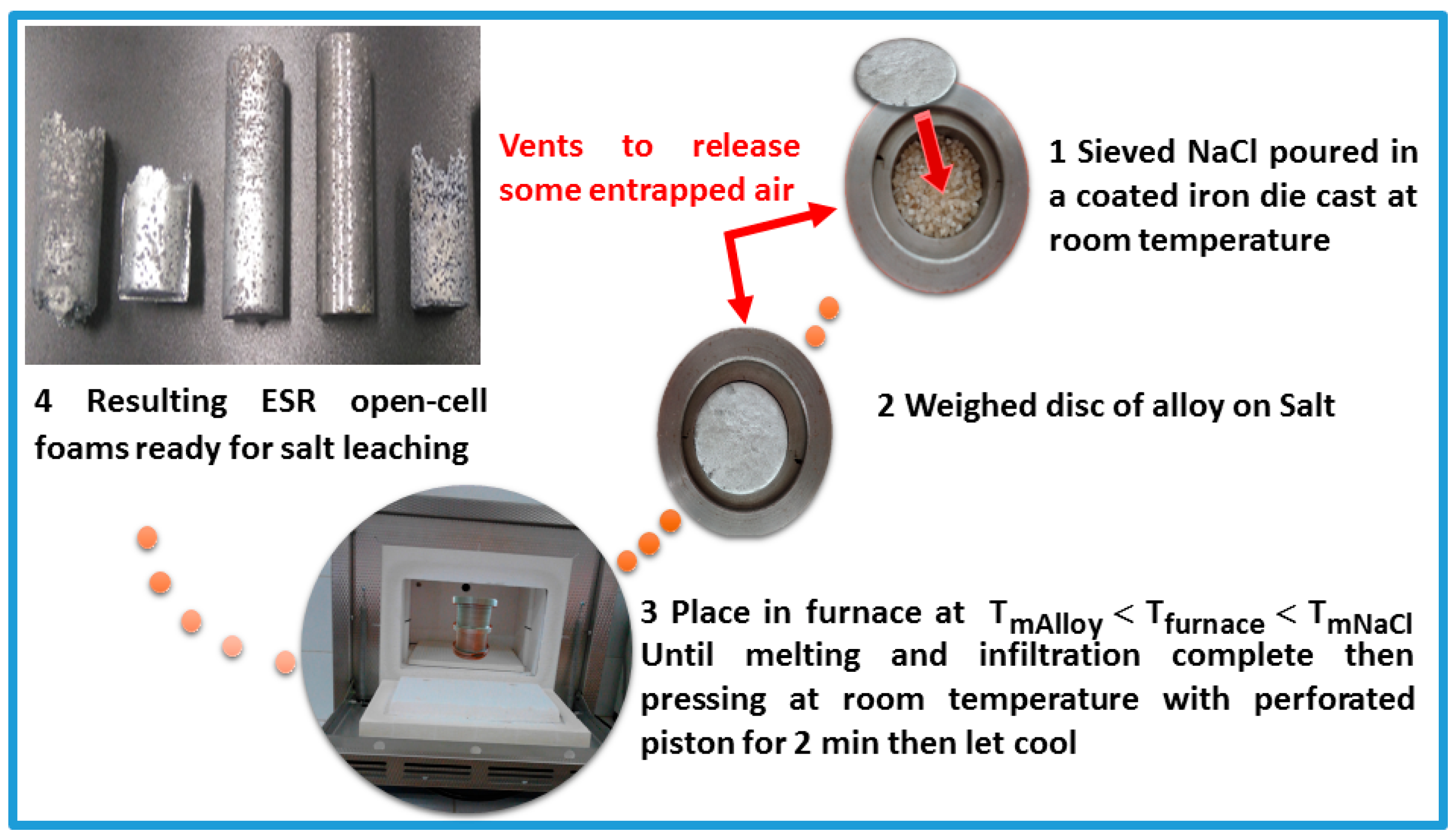
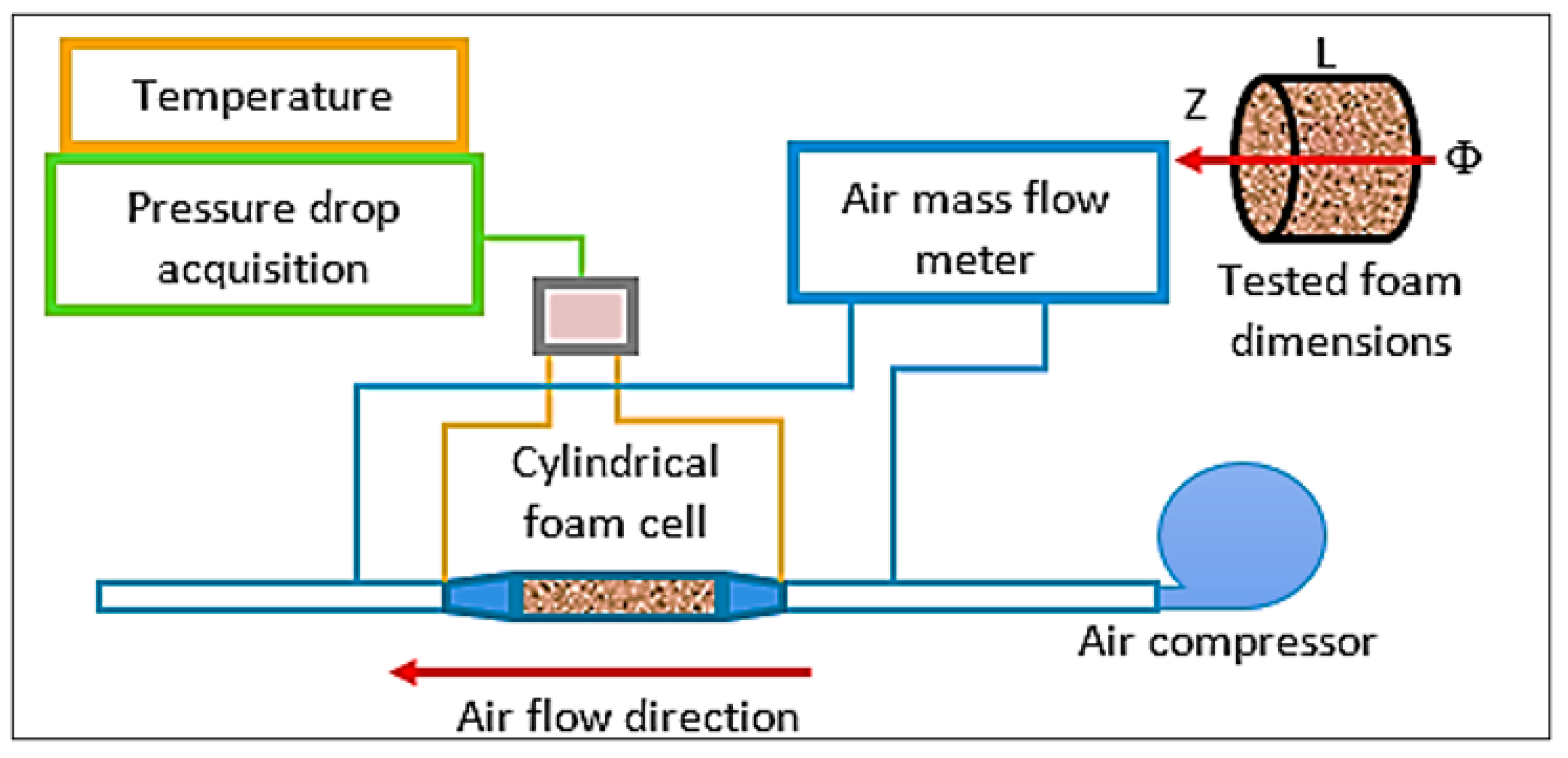

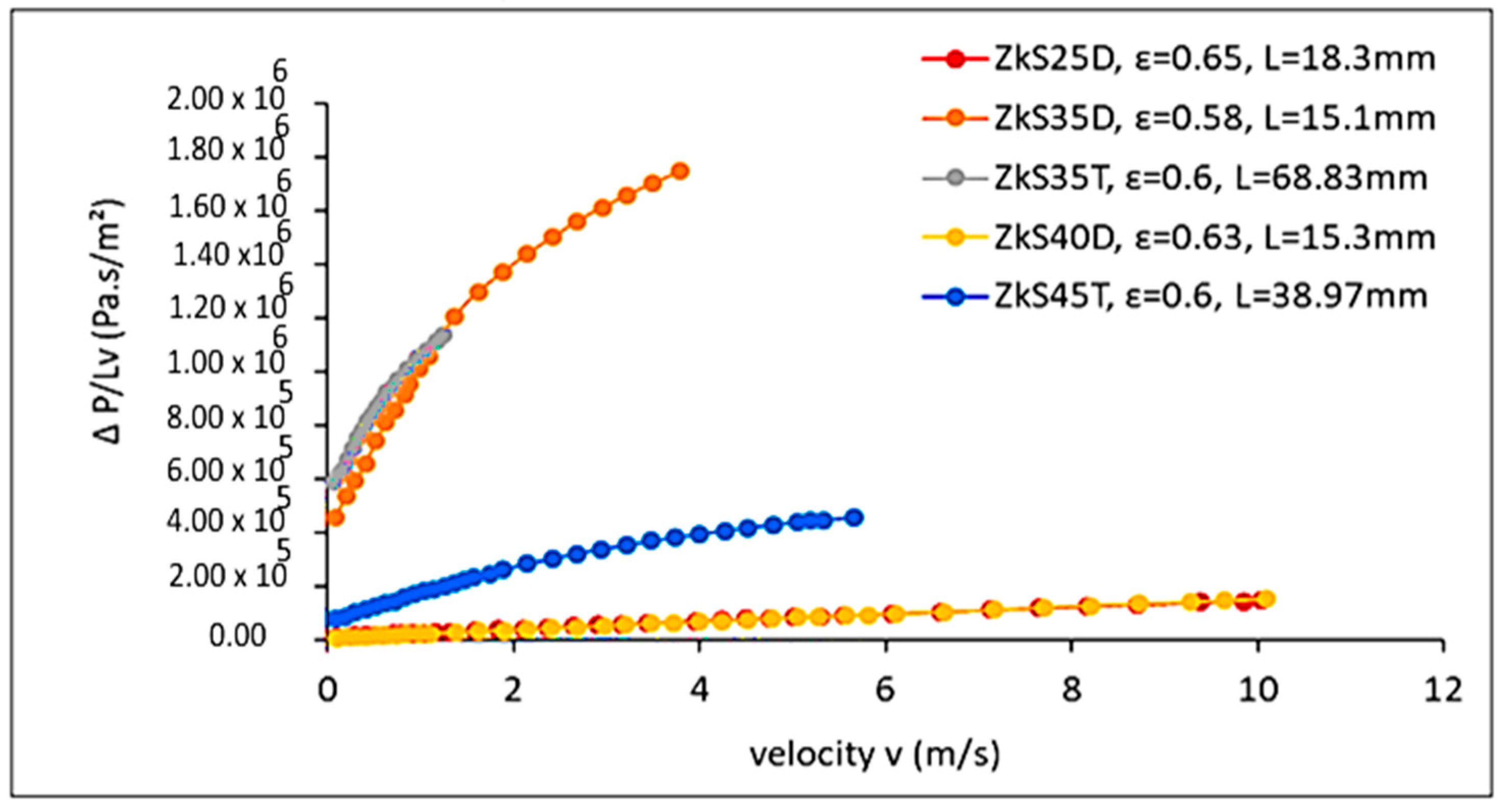

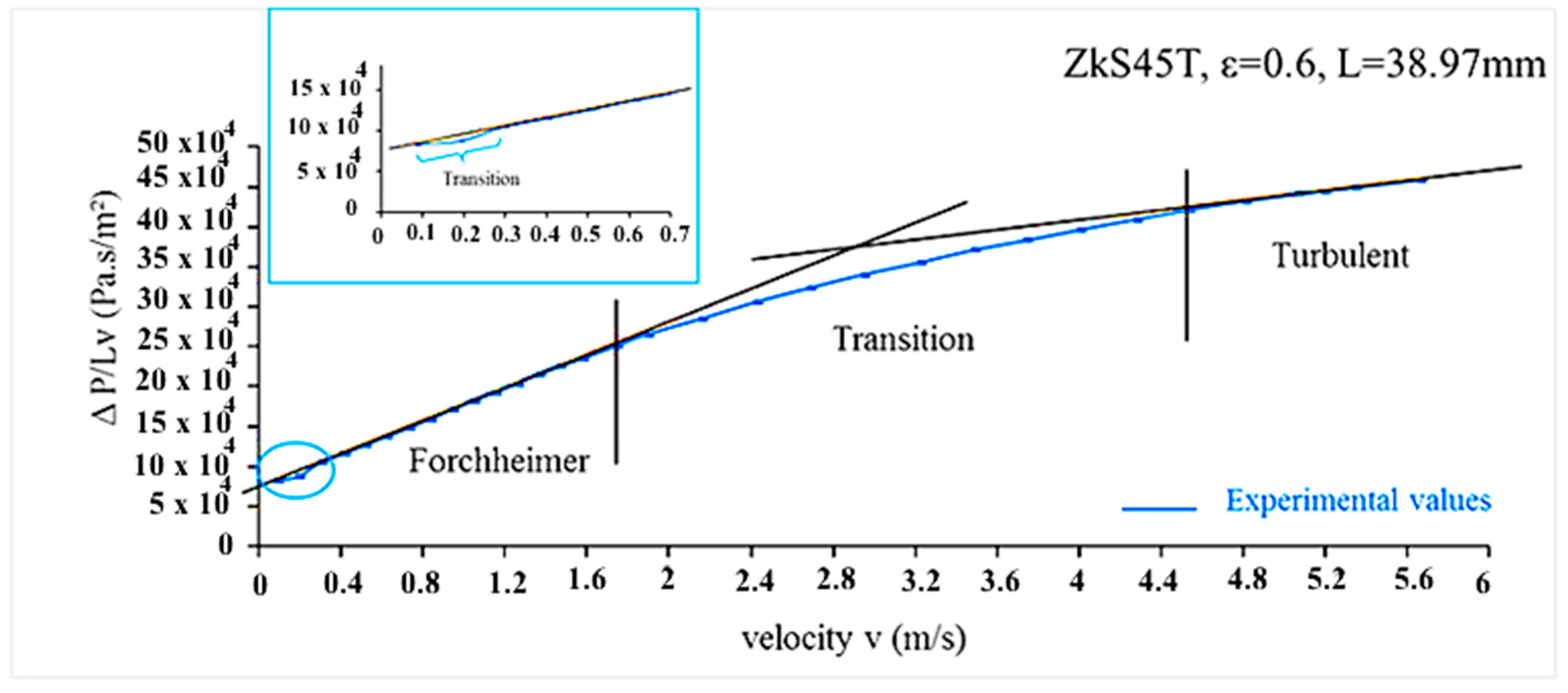
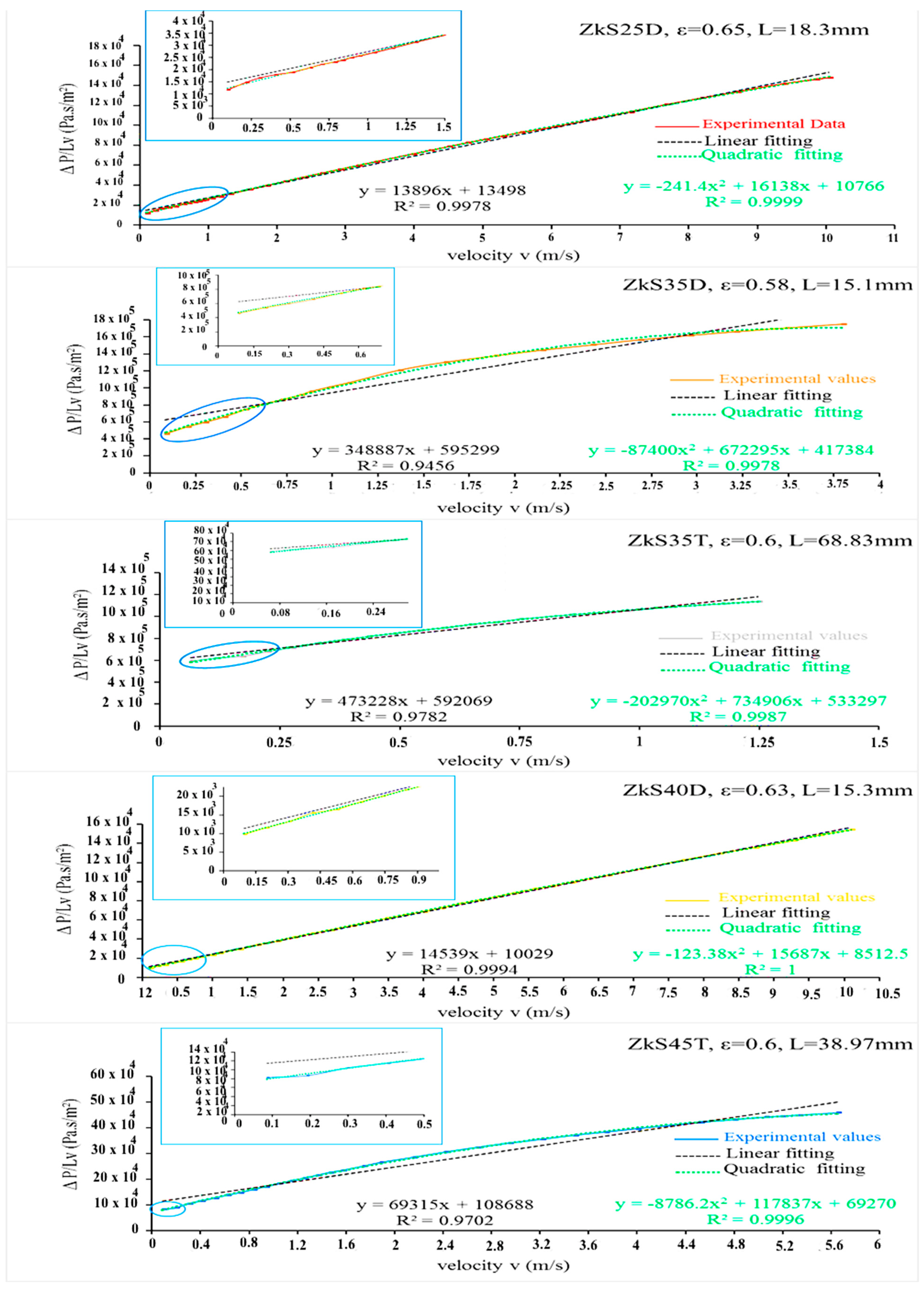
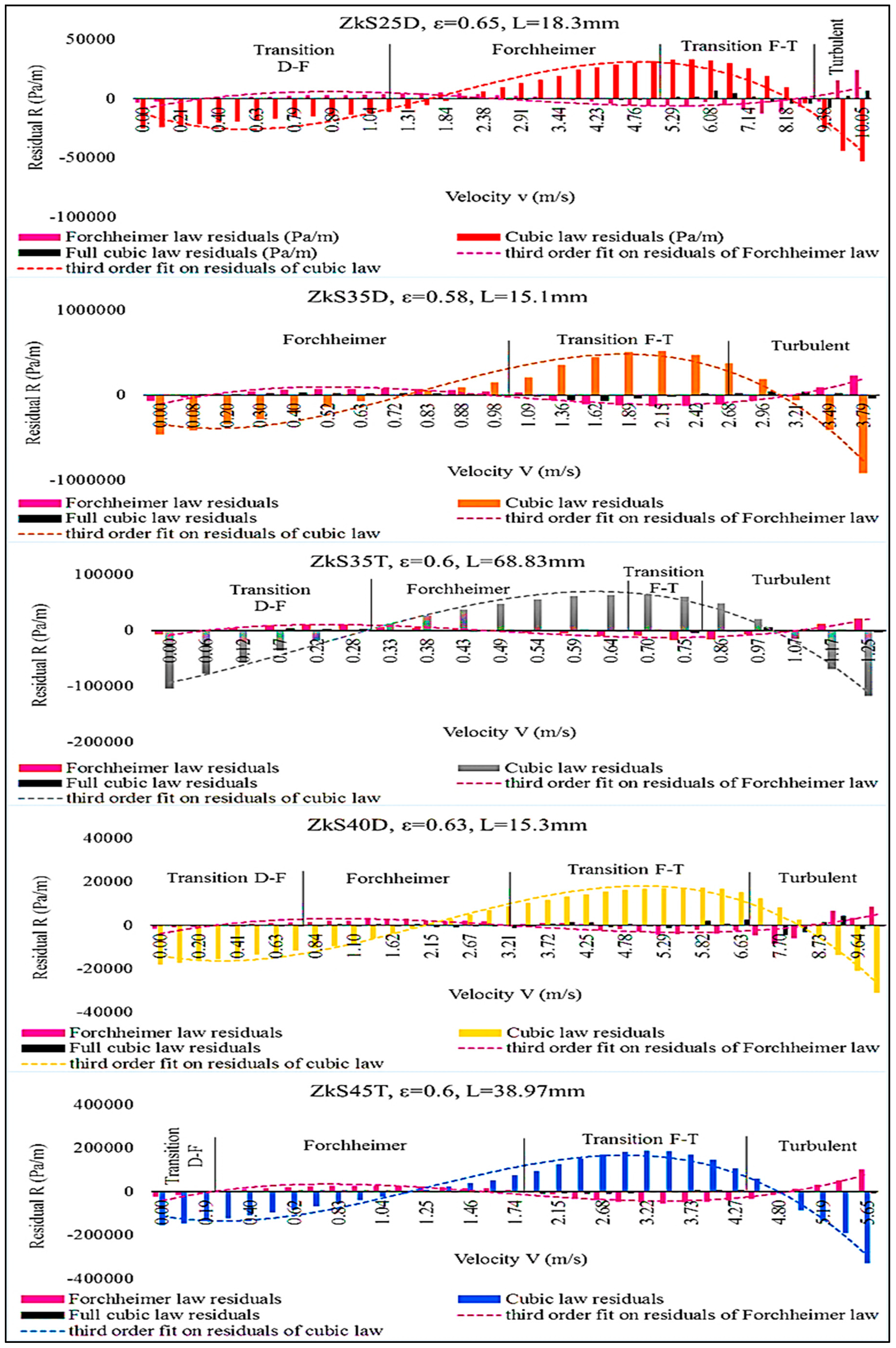
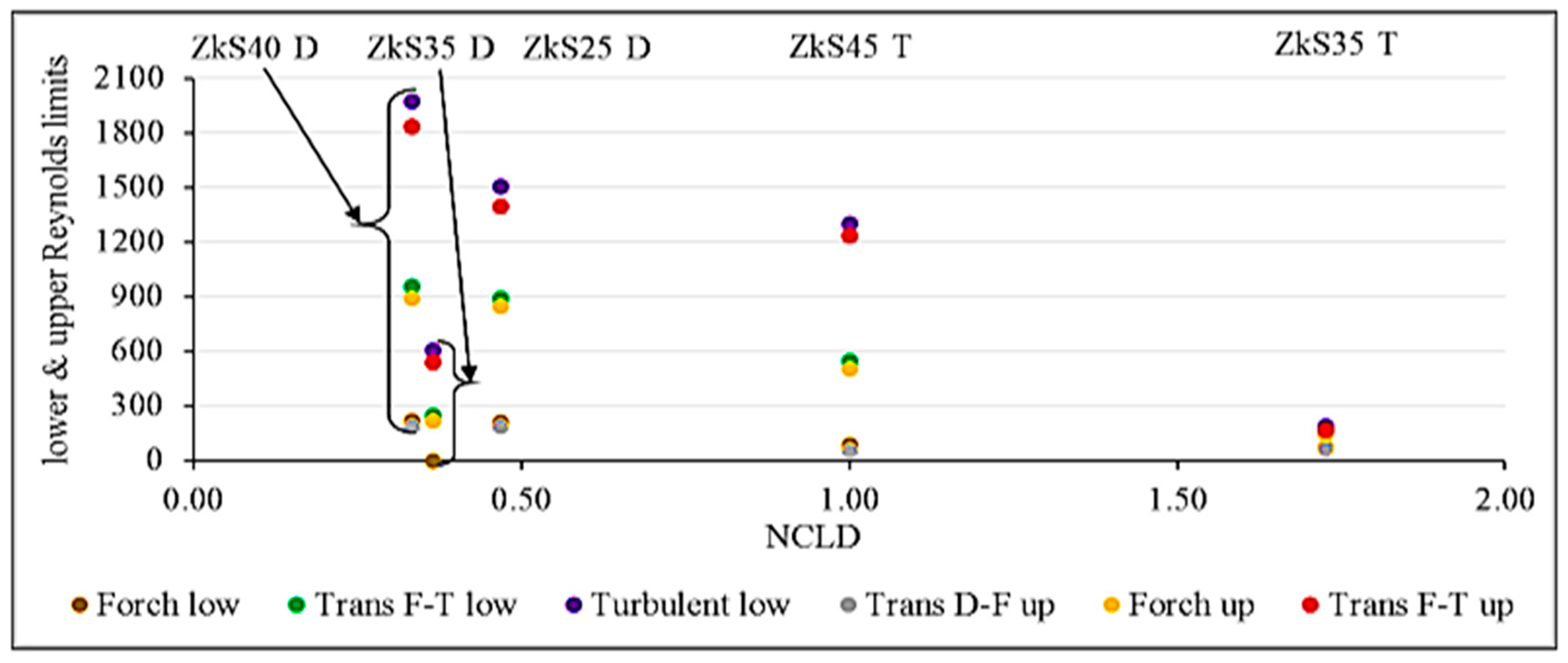
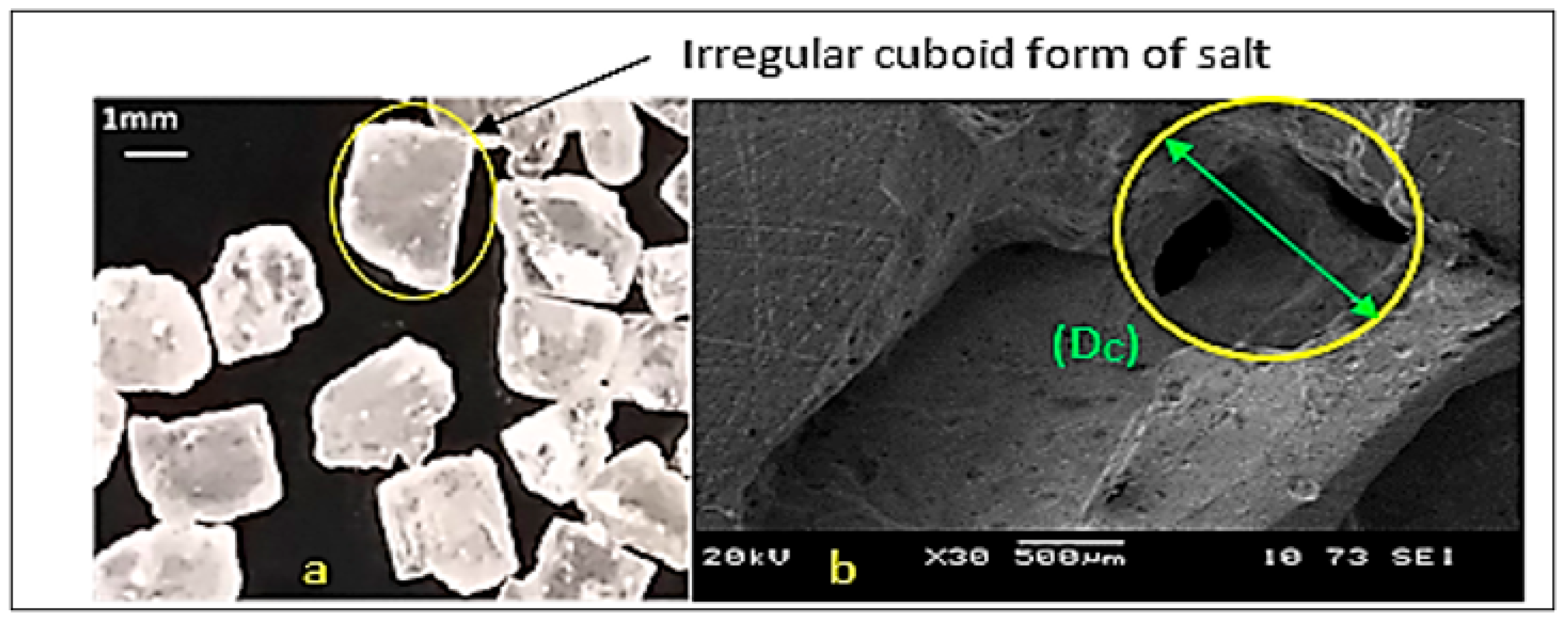

| Foam | L (mm) | Φ (mm) | DC (mm) | ε (%) | NCL | NCD | NCLD |
|---|---|---|---|---|---|---|---|
| ZkS25D | 18.30 | 37.50 | 2.50 | 64.77 | 7 | 15 | 0.47 |
| ZkS35D | 15.10 | 38.18 | 3.50 | 57.65 | 4 | 11 | 0.36 |
| ZkS35T | 68.83 | 38.18 | 3.50 | 59.73 | 19 | 11 | 1.73 |
| ZkS40D | 15.30 | 38.09 | 4.00 | 62.56 | 3 | 9 | 0.33 |
| ZkS45T | 38.97 | 38.28 | 4.50 | 60.00 | 8 | 8 | 1.00 |
| Sample | Transition D–F | Forchheimer | Transition F–T | Turbulent | Full Range |
|---|---|---|---|---|---|
| ZKS25 D | 3.32 | −31.09 | −48.61 | −47.53 | −48.84 |
| ZKS35 D | - | −8.13 | −47.61 | −22.73 | −39.06 |
| ZKS35 T | 7.64 | −4.17 | 38.36 | −8.43 | −18.65 |
| ZKS40 D | −0.50 | −11.79 | −38.21 | 101.43 | −35.72 |
| ZKS45 T | 0.00 | −13.59 | −44.50 | −61.60 | −52.94 |
| Full Cubic Permeability KFC (m²) | Forchheimer Permeability KForch (m²) | |||||||||
|---|---|---|---|---|---|---|---|---|---|---|
| Sample | Transition D–F | Forchheimer | Transition F–T | Turbulent | Full Range * | Transition D–F | Forchheimer | Transition F–T | Turbulent | Full Range * |
| ZkS25 D | 1.58 × 10−9 | 1.96 × 10−9 | 1.83 × 10−9 | 6.31 × 10−10 | 1.83 × 10−9 | 1.63 × 10−9 | 1.35 × 10−9 | 9.41 × 10−10 | 3.31 × 10−10 | 9.35 × 10−10 |
| ZkS35 D | - | 4.75 × 10−11 | 4.49 × 10−11 | 2.15 × 10−11 | 3.60 × 10−11 | - | 4.36 × 10−11 | 2.35 × 10−11 | 1.66 × 10−11 | 2.19 × 10−11 |
| ZkS35 T | 3.23 × 10−11 | 3.32 × 10−11 | 2.49 × 10−11 | 2.73 × 10−11 | 3.49 × 10−11 | 3.48 × 10−11 | 3.18 × 10−11 | 3.45 × 10−11 | 2.50 × 10−11 | 2.84 × 10−11 |
| ZkS40 D | 2.18 × 10−9 | 2.34 × 10−9 | 2.48 × 10−9 | 4.65 × 10−10 | 2.19 × 10−9 | 2.17 × 10−9 | 2.07 × 10−9 | 1.53 × 10−9 | 9.37 × 10−10 | 1.41 × 10−9 |
| ZkS45 T | 2.36 × 10−10 | 2.84 × 10−10 | 2.03 × 10−10 | 1.78 × 10−10 | 2.35 × 10−10 | 2.36 × 10−10 | 2.46 × 10−10 | 1.12 × 10−10 | 6.83 × 10−11 | 1.11 × 10−10 |
| C1 (m−1) (Full Cubic Law) | β (m−1) (Forchheimer Law) | |||||||||
|---|---|---|---|---|---|---|---|---|---|---|
| Sample | Transition D–F | Forchheimer | Transition F–T | Turbulent | Full Range | Transition D–F | Forchheimer | Transition F–T | Turbulent | Full Range |
| ZkS25 D | 11,583.49 | 14,100.64 | 13,179.79 | 12,188.00 | 13,611.91 | 12,442.48 | 11,959.30 | 10,910.22 | 7561.98 | 10,770.95 |
| ZkS35 D | - | 589,388.41 | 609,391.31 | 269,496.22 | 469,425.78 | - | 495,386.93 | 24,8916.45 | 137,176.77 | 206,951.25 |
| ZkS35 T | 140,171.70 | 521,216.88 | 0.00 | 359,694.79 | 606,814.26 | 524,663.65 | 436,902.63 | 480,645.54 | 258,975.56 | 328,123.88 |
| ZkS40 D | 13,047.41 | 13,472.89 | 13,350.30 | 7278.47 | 13,063.34 | 12,894.31 | 12,650.44 | 11,907.28 | 11,085.37 | 11,706.81 |
| ZkS45 T | 34,851.68 | 100,090.94 | 88,252.99 | 82,705.81 | 92,231.81 | 34,851.68 | 84,141.38 | 48,054.40 | 27,310.87 | 44,912.40 |
| C2 (-) (Full Cubic Law) | |||||
|---|---|---|---|---|---|
| Sample | Transition D–F | Forchheimer | Transition F–T | Turbulent | Full Range |
| ZkS25 D | 0.0083 | −0.0045 | −0.0024 | −0.0037 | −0.0033 |
| ZkS35 D | - | −1.0708 | −1.5207 | −0.3152 | −0.8304 |
| ZkS35 T | 15.1539 | −1.3040 | 5.1841 | −0.7381 | −2.5935 |
| ZkS40 D | −0.0023 | −0.0027 | −0.0020 | 0.0033 | −0.0016 |
| ZkS45 T | 0.0000 | −0.1043 | −0.0970 | −0.0846 | −0.1008 |
| Re Lower Limit | Re Upper Limit | |||||||
|---|---|---|---|---|---|---|---|---|
| Sample | Transition D–F | Forchheimer | Transition F–T | Turbulent | Transition D–F | Forchheimer | Transition F–T | Turbulent |
| ZkS25 D | / | 209.24 | 889.48 | 1502.79 | 185.42 | 847.35 | 1395.07 | / |
| ZkS35 D | / | 0 | 244.48 | 602.00 | - | 220.82 | 542.93 | / |
| ZkS35 T | / | 73.59 | 156.36 | 191.86 | 61.74 | 144.56 | 168.15 | / |
| ZkS40 D | / | 216.24 | 954.68 | 1973.65 | 189.27 | 889.61 | 1836.3 | / |
| ZkS45 T | / | 85.87 | 543.98 | 1304.24 | 55.22 | 501.36 | 1231.52 | / |
Disclaimer/Publisher’s Note: The statements, opinions and data contained in all publications are solely those of the individual author(s) and contributor(s) and not of MDPI and/or the editor(s). MDPI and/or the editor(s) disclaim responsibility for any injury to people or property resulting from any ideas, methods, instructions or products referred to in the content. |
© 2023 by the authors. Licensee MDPI, Basel, Switzerland. This article is an open access article distributed under the terms and conditions of the Creative Commons Attribution (CC BY) license (https://creativecommons.org/licenses/by/4.0/).
Share and Cite
Hassein-Bey, A.H.; Belhadj, A.-E.; Tahraoui, H.; Toumi, S.; Sid, A.N.E.H.; Kebir, M.; Chebli, D.; Amrane, A.; Zhang, J.; Mouni, L. Experimental Investigation of Fluid Flow through Zinc Open-Cell Foams Produced by the Excess Salt Replication Process and Suitable as a Catalyst in Wastewater Treatment. Water 2023, 15, 1405. https://doi.org/10.3390/w15071405
Hassein-Bey AH, Belhadj A-E, Tahraoui H, Toumi S, Sid ANEH, Kebir M, Chebli D, Amrane A, Zhang J, Mouni L. Experimental Investigation of Fluid Flow through Zinc Open-Cell Foams Produced by the Excess Salt Replication Process and Suitable as a Catalyst in Wastewater Treatment. Water. 2023; 15(7):1405. https://doi.org/10.3390/w15071405
Chicago/Turabian StyleHassein-Bey, Amel Hind, Abd-Elmouneïm Belhadj, Hichem Tahraoui, Selma Toumi, Asma Nour El Houda Sid, Mohammed Kebir, Derradji Chebli, Abdeltif Amrane, Jie Zhang, and Lotfi Mouni. 2023. "Experimental Investigation of Fluid Flow through Zinc Open-Cell Foams Produced by the Excess Salt Replication Process and Suitable as a Catalyst in Wastewater Treatment" Water 15, no. 7: 1405. https://doi.org/10.3390/w15071405
APA StyleHassein-Bey, A. H., Belhadj, A.-E., Tahraoui, H., Toumi, S., Sid, A. N. E. H., Kebir, M., Chebli, D., Amrane, A., Zhang, J., & Mouni, L. (2023). Experimental Investigation of Fluid Flow through Zinc Open-Cell Foams Produced by the Excess Salt Replication Process and Suitable as a Catalyst in Wastewater Treatment. Water, 15(7), 1405. https://doi.org/10.3390/w15071405









